Five years ago on a summer day, we set out to learn more about this thing called blogging. We made a little survey, did a lot of outreach and eventually got 1000 bloggers to respond.
You are now reading the 2019 Annual Blogging Survey. In it, you’ll find a goldmine of blogging statistics, data and trends. Together, the numbers tell the story of huge changes in blogging and content marketing.
We’ll be answering…
- How long does it take to write a blog post?
- How long is the typical blog post?
- How frequently do bloggers publish?
- What content formats are bloggers using?
- What does the typical blog post include?
- How many draft headlines are bloggers writing?
- Are bloggers working with editors?
- How is your content typically promoted?
- How often do bloggers research keywords?
- Are bloggers using analytics?
- Is it part of your strategy to update older blog posts?
- Are bloggers getting results from their content?
Here is a sample of the stats you’ll find:
- The average blog post takes 3 hours and 57 minutes to write …up 65% from 2014
- The average blog post is 1236 words long …56% longer than in 2014
- 52% of bloggers report that it’s getting harder to get readers to engage with their content
One of the final questions is about success, and we correlate that answer with the other answers, we can see what’s working today. Here is the summary, ordered by effectiveness. It shows not only shows which tactics are the most effective, but how few bloggers use them.

Note: “Strong results” data is self-reported and naturally depends on the goals of each blogger. Because results such as traffic, engagement and revenue vary widely across content programs, we did not ask bloggers to provide Analytics or revenue data. You’ll find more info about the methodology and data at the end of this report.
Here are the final statistics, analysis and input from blogging and content marketing experts.
1. How long does it take to write a blog post?
The average blog post takes 3 hours and 57 minutes to write.
The time invested in each article rises every year. This year the average time spent per post jumped 30 minutes and is up 65% since 2014.
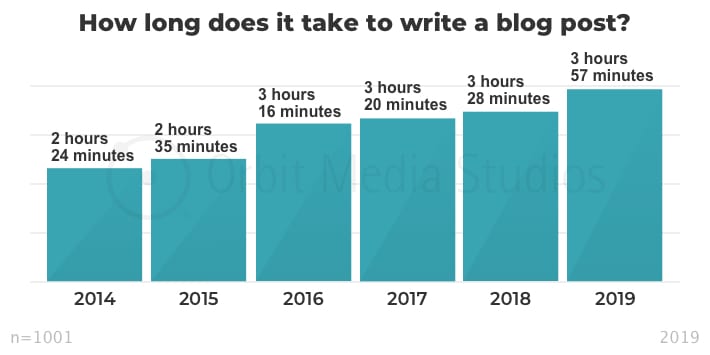
The data from 2014 to 2016 showed big drops in bloggers who spent two hours or less per article. This year we see big jumps in the percentage of bloggers who spend four hours or more.

Does the extra time and effort pay off? Yes, bloggers who spend more time per post are the most likely to be successful.
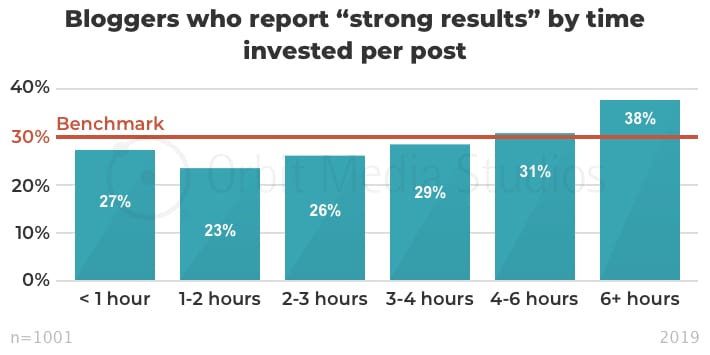
Note: 30% of bloggers reported “strong results.” That’s the benchmark. We’ll discuss this in the final section.
2. How long is the typical blog post?
The average blog post is 1236 words long.
That’s 53% longer than six years ago. Articles keep getting longer, as bloggers invest more time and effort in long-form, detailed articles.
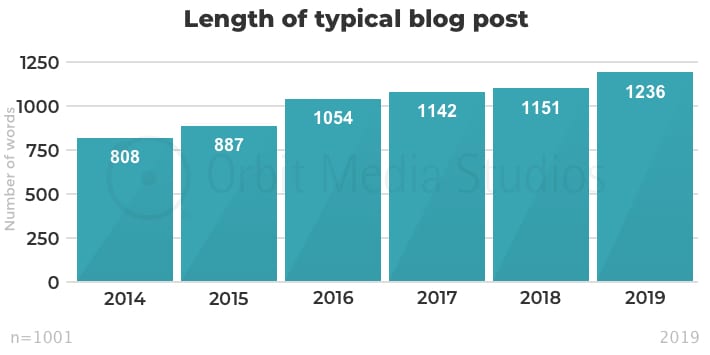
Look closer and we see the big jump is in the 1500-2000 word range. It’s as if editors everywhere updated their guidelines for length from 1000 to 1500 words.
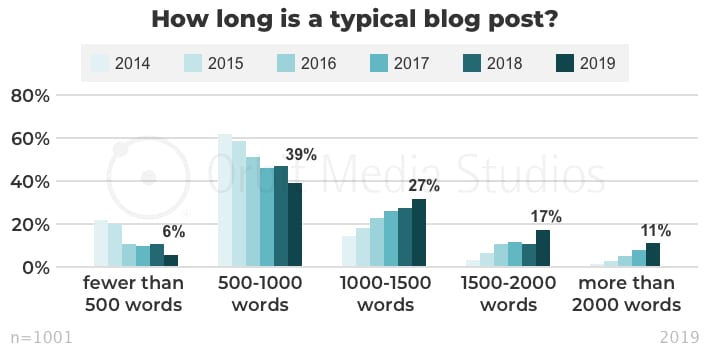
Compare the percentage of bloggers at the far ends of the spectrum. An approach that was once rare is now quite common.
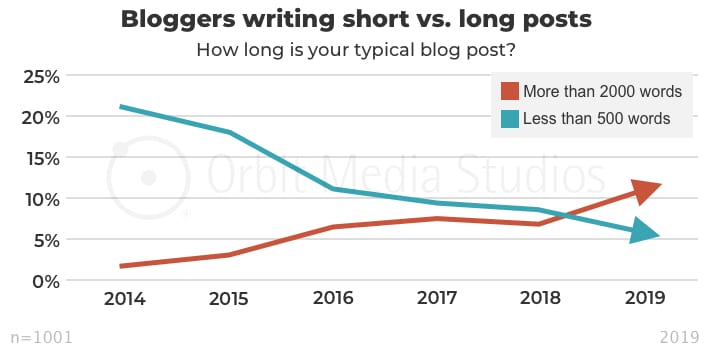
Perhaps we’ve seen a tipping point in the awareness of the benefits of big content. Lots of studies have found a correlation between long-form content with higher rankings, greater social engagement and better results in general. Here’s one more: bloggers who write longer content are far more likely to report success. More than half of the bloggers who go big report “strong results” from blogging.
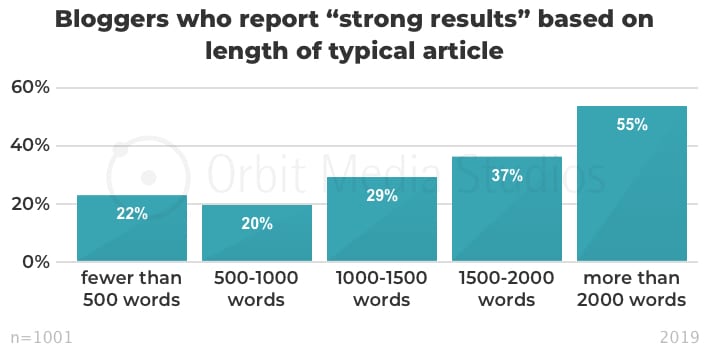
 |
Joe Pulizzi, Founder, CONTENT MARKETING INSTITUTE“In looking through the data, it’s almost like going into the past where longer, meatier articles were king, and each article took hours of time. This gives me hope for the future of content consumption. At least for blogging, snackable content is clearly dead. Audiences expect more, and bloggers are giving them better researched more advanced and well-thought-out content.” |
 |
gill andrews, COPYWRITER AND WEB CONSULTANT“I am surprised by how much the average blog post length has increased over time. It either means that more bloggers have finally realized that they need to try harder to get results or that the reader’s expectations increased drastically. If it’s the latter, I wonder if that means that at some point in the future, small businesses won’t be able to blog at all, because they won’t have the resources to produce the content an average online reader expects.” |
 |
gini dietrich, founder and author, SPINSUCKS“There are many days I complain about how I have six hours of meetings without time to pee or eat, let alone write or record a podcast. And then I read this survey that shows a significant number of bloggers now spend six hours writing one blog post. Six hours! ONE blog post. This means that kind of time, research, and collaboration results in cold, hard cash. So pack your desk drawer with protein-packed snacks and get to work!” |
3. How frequently do bloggers publish?
About half of bloggers publish weekly or several times per month.
Has the increase in time and length affected how often bloggers hit the publish button? Yes. There has been a steady decline in the “several per week” category since 2014.
Around half of all bloggers publish 2-4 posts per month. That’s holding steady, but notice the jump in daily blogging.
Is there a relationship between publishing frequency and results? Yes. Bloggers who write more (either in length or in frequency) are more likely to report strong results. But there seems to be a point of diminishing returns with frequency. Bloggers who publish daily are more likely to report strong results than bloggers who publish several times per day.
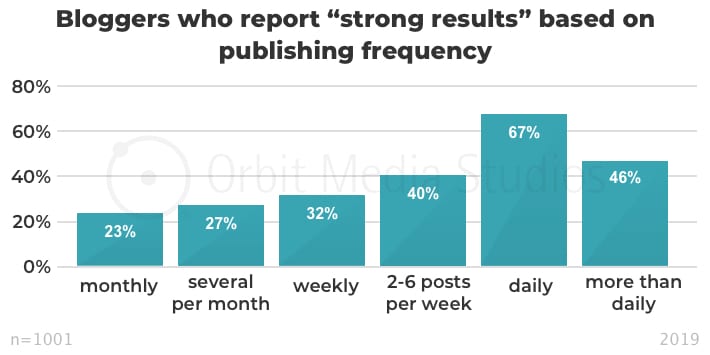
4. What content formats are bloggers using?
We’ve seen the size. Now let’s look at the shape of the content.
- Practical, how-to content is dominant in content strategies.
- About half of bloggers publish news. About half publish opinion.
- Just one-third of bloggers use collaborative formats: round ups and interviews.
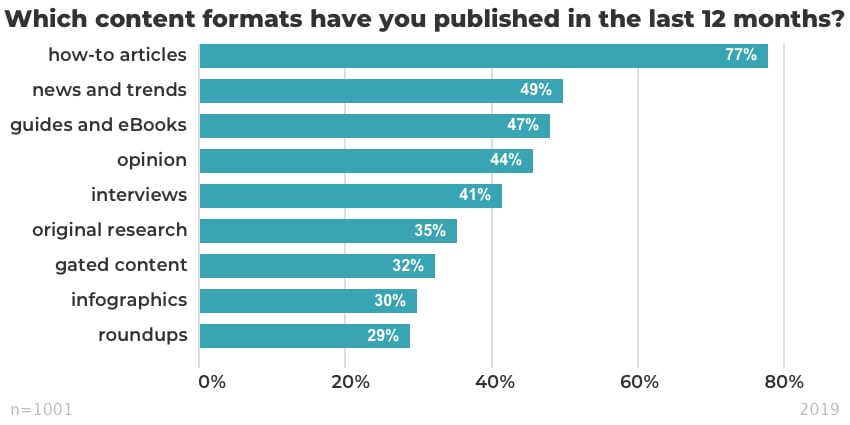
Here is the correlation between content formats and blogging performance. This reinforces the previous findings about the value of in-depth, visual and collaborative content.
- Most likely to succeed: Bloggers who create long-form guides, ebooks and original research
- Least likely to succeed: Bloggers who publish news and opinion
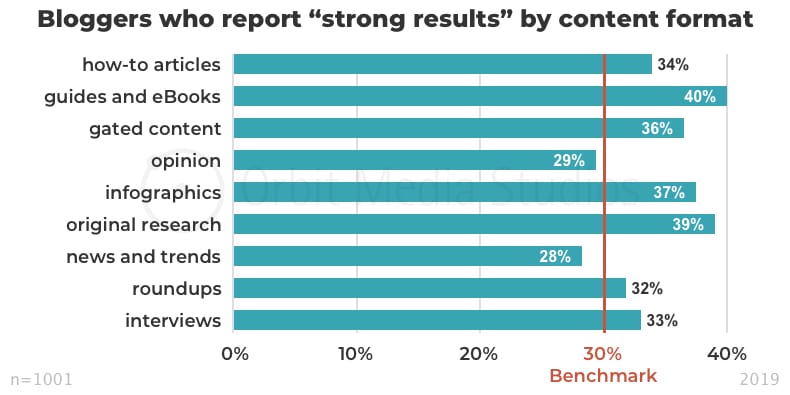
Mega-Trend: Research on the rise
Last year, 25% of bloggers added original research to their mix. Now we see a big jump up in that number. More bloggers are conducting and publishing original research as the word gets out about its effectiveness.
- 35% of bloggers conduct and publish original research
- 85% of bloggers who publish original research report some/strong results from blogging (39% of them report strong results)
To gate or not to gate
This year we asked if bloggers are putting content behind lead gen forms, requiring readers to give their email address prior to getting access. About one-third of bloggers do this, even though almost half of bloggers publish guides and ebooks.
- 32% of bloggers gate content
- 88% of bloggers who gate content report some/strong results from blogging (35% of them report strong results)
5. What does the typical blog post include?
Now let’s look at the features of specific articles, including images, video, statistics and contributor quotes. These statistics show how visual, scannable and collaborative blog posts are in general.
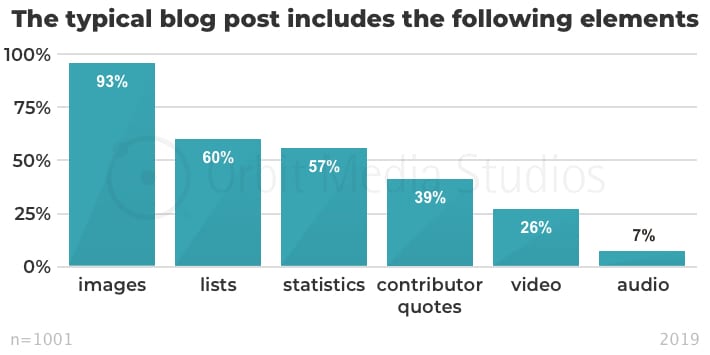
When we check the correlation data, you can see which specific elements correlate with success when included in blog content.
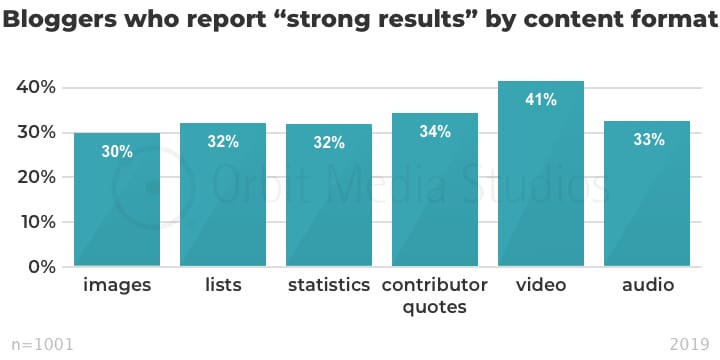
You can see that video makes the biggest difference. We’ve seen the correlation between video and success grow year after year.
Just how visual is blog content?
Most bloggers add a few images to their content. But fewer than 10% of bloggers are producing very visual content with 7+ images per article. Does that sound high? The average article here on the Orbit Media blog includes 14 images, not including the author’s picture.
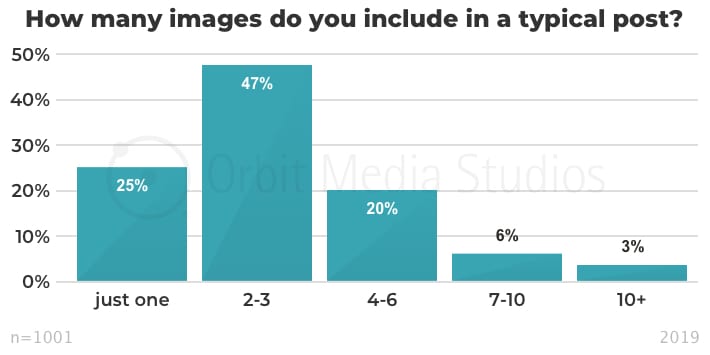
There is a clear correlation between highly visual content and success. The more images a blogger adds to a typical article, the more likely they are to win at the content game.
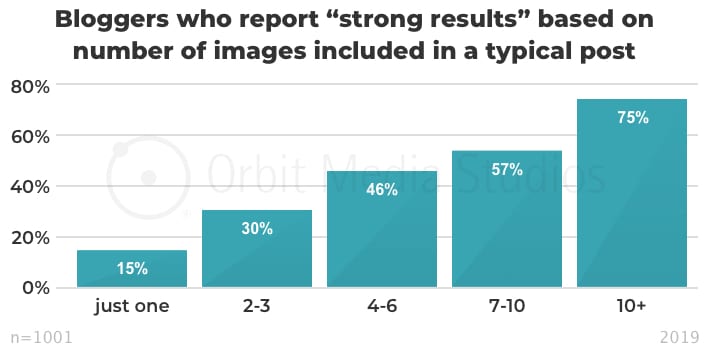
Just 3% of bloggers add 10+ images per article, but they are 2.5x more likely to report “strong results” than the average blogger.
This along with the trends in video shows the importance of visuals. It shows just how visual blogging has become. Is blogging more about images or words? Are blogs post written or designed? It seems the more visual the content strategy, the more likely it is to succeed.
Just how collaborative is blog content?
Seeing the big trends of influencer marketing inspired us to ask about the popularity of collaborative content, which we define as content that includes contributor quotes, roundups or interviews. The response indeed shows that most bloggers do collaborate.
- 32% of bloggers never collaborate
- 1% of bloggers always collaborate
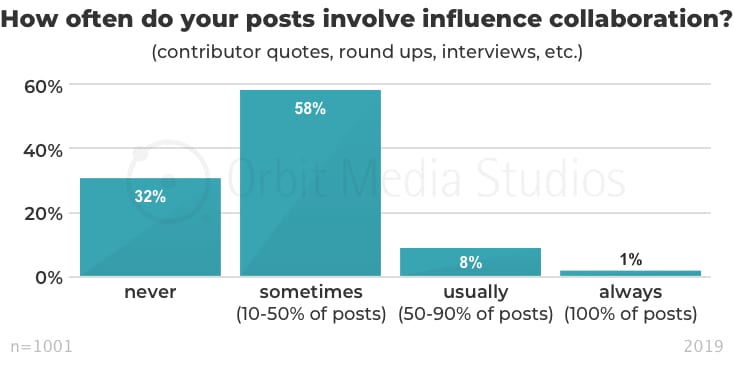
Is there a correlation between collaboration and success? Yes. The more often bloggers collaborate with influencers, the more likely they are to report “strong results.”
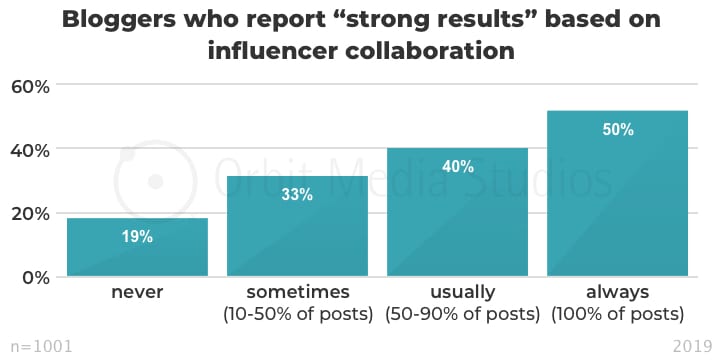
Here at Orbit, as a rule, each article we write includes a contributor quote from at least one expert. Just as a journalist wouldn’t publish an article without a source, we would never publish an article without an expert POV.
6. How many draft headlines are bloggers writing?
The average blogger writes four headlines before selecting one.
Everyone sweats over headlines, or so we assume. As an all-important element for blog posts, it’s worth the extra attention. After hearing that some content teams consider 20+ headlines before selecting one, we decided to pose the question.
We see that most bloggers write a couple of headlines before choosing one and a tiny percentage are writing more than ten. Fewer than 1% of bloggers write 20+ draft headlines per article.
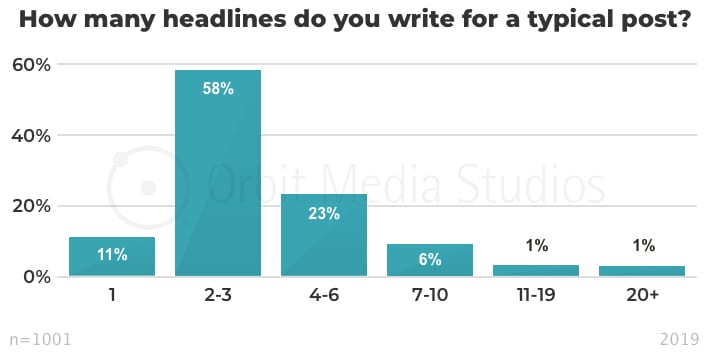
Yet bloggers who consider more headlines are far more likely to report success. Very few bloggers are doing the thing that correlates with results.
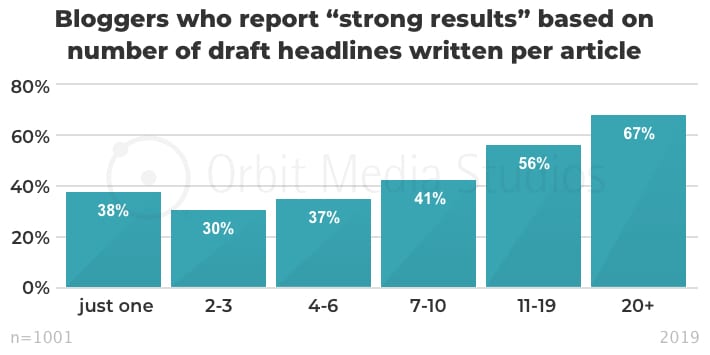
 |
ann handley, Cheif content officer, MARKETING PROFS“We all recognize the value of a great headline. Well done, us! Now let’s spend as much time thinking about the first line of a piece. PRO TIP: Write as many first lines as you do headlines. Why? Because the headline makes a reader click. And the first line makes them actually read the piece.” |
7. Are bloggers working with editors?
30% of bloggers have a formal process for editing.
For our final question about process, we ask about working with editors. Most bloggers edit their own work or get “a second set of eyes” on their content before publishing. Only 30% have a formal process for editing. That’s way up from five years ago when just 1 in 10 bloggers had a formal process.
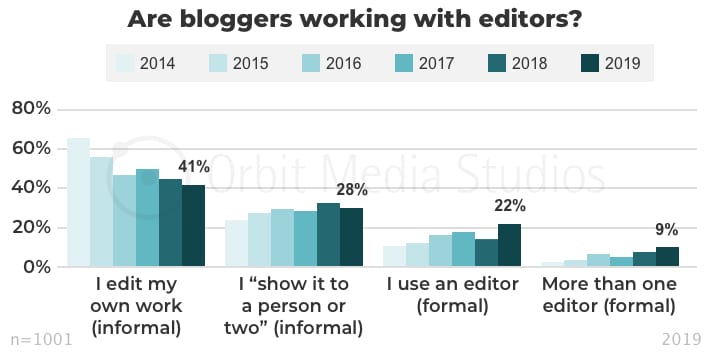
Bloggers with a formal editing process were about 50% more likely to report strong results. Working with multiple editors doesn’t seem to make strong outcomes more likely. And bloggers who edit their own seem to be doing pretty well.
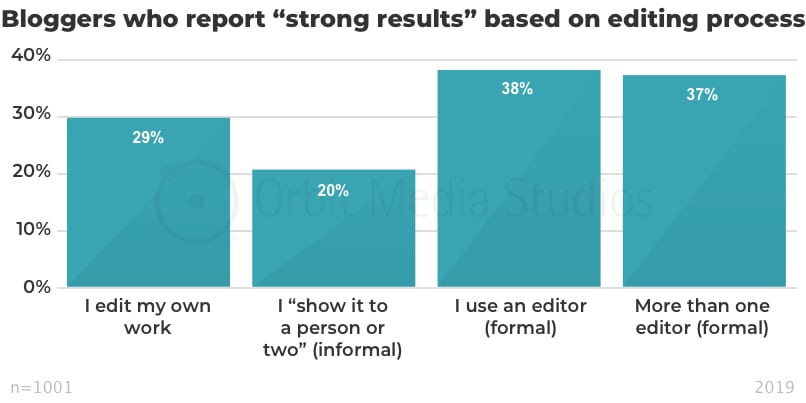
Another tip from Ann: “Behind every decent writer is a fantastic editor! If you want to be a better writer… get yourself a great editor to work with you.”
8. How is your content typically promoted?
Social media, of course. But just one in five bloggers uses influencer outreach and paid promotion.
Obviously, the fast, easy and cheap promotion channel is the most popular. Virtually all bloggers share their content on social media. Two-thirds use search and email, both of which have become much more popular over the last five years.
- The percentage of bloggers using email marketing has increased 2x since 2014
- The percentage of bloggers using paid promotion has increased 3x since 2014
- 1 in 5 bloggers leverages influencers to help drive traffic (that’s down from two years ago)
- 1 in 5 bloggers buys traffic (that’s leveled off after a dramatic rise)
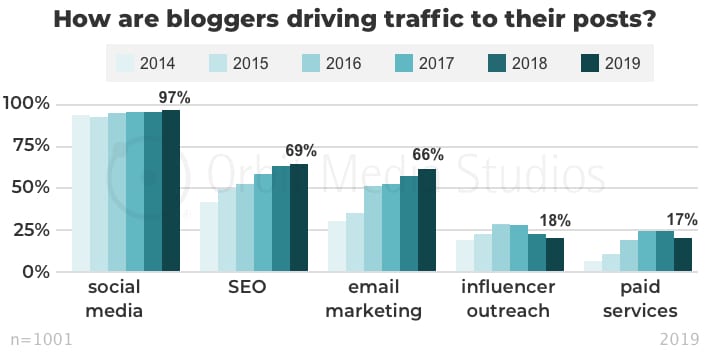
Let’s see what’s working. The less popular promotion channels are more strongly correlated with success. This may be because they are more difficult (or expensive) and this is another example of hard work paying off.
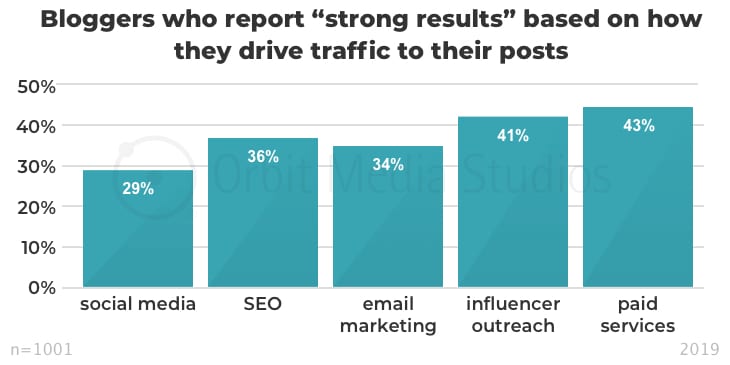
9. How often do bloggers research keywords?
Half of bloggers research keywords for the majority of their content.
As SEO has grown in popularity and importance, keyword research as a skill and practice has become more common. Most bloggers do it sometimes. Half of all bloggers do it most of the time.
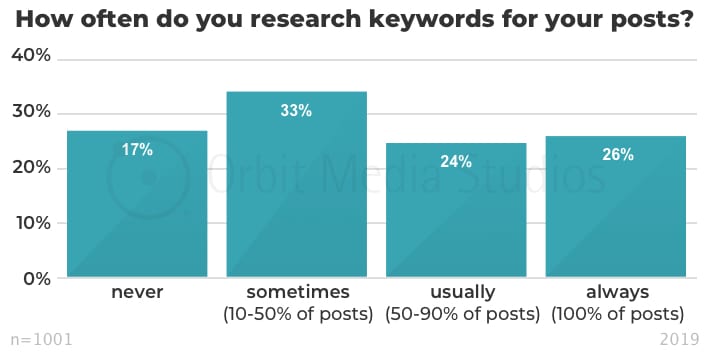
It’s work that pays off. The more the blogger researches keywords, the more likely they are to report success. Bloggers who are also SEOs report “strong results” at much higher than average rates.
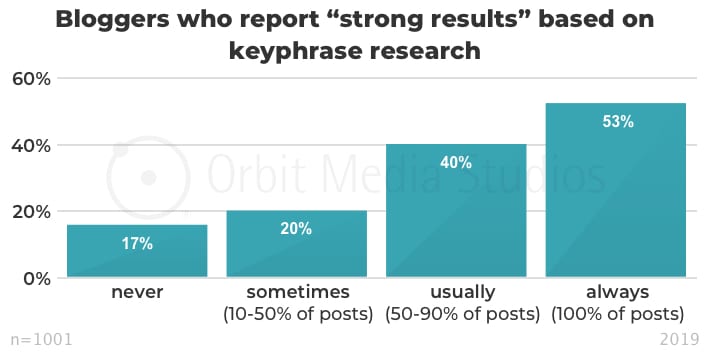
10. Are bloggers using analytics?
Half of bloggers usually check the analytics for a post. The other half check occasionally, rarely or never.
The trend here is mostly flat. Use of Analytics has remained steady for years. But it remains one of the big indicators of blogging performance. Bloggers who measure the performance of every post are far more likely to report “strong results” than the average blogger.
If they aren’t using analytics, you have to wonder how they even know if they’re getting results.
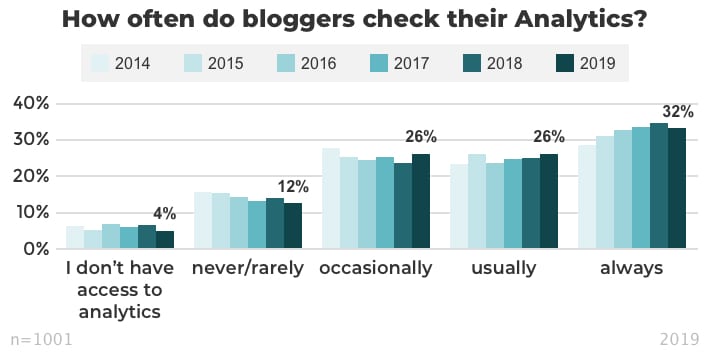
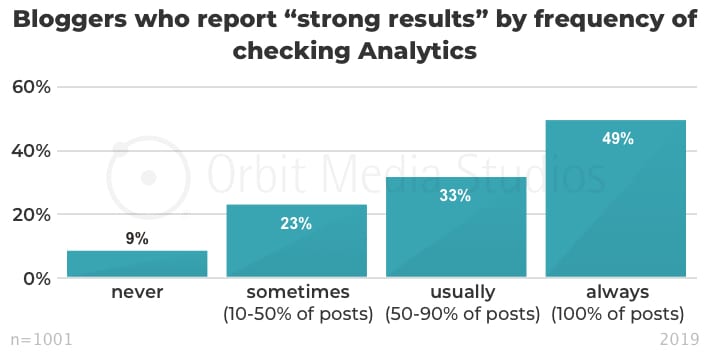
 |
jay baer, luminary, CONVINCE AND CONVERT“What’s most interesting to me is the combination of expanded blog post length and corresponding time spent per post with the decline in attention paid to Analytics and keyword research. It’s remarkable to me that bloggers would spend nearly 4 hours to craft an 1800 word post, yet only 57% of them check their analytics with any degree of frequency and only about 50% of the time are they actually thinking about keywords when writing that post. If I was going to spend four hours on something, I would want to make sure that I had a measurement and success schema identified before I wrote the first of those 1800 words.” |
11. Is it part of your strategy to update older blog posts?
Two-thirds of bloggers update previously published blog posts.
An obvious trend has emerged since we started asking this question a few years ago. Nearly 70% of bloggers now report going back to older content and making updates.
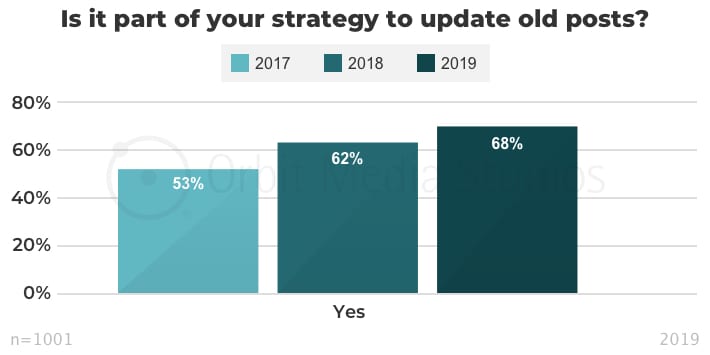
 |
ian cleary, founder, RAZOR SOCIAL“Updating old content is an essential part of any online strategy so it’s good to see that this year the percentage of people updating old content. It’s great for SEO, especially when combined with keyword research, adding more media and careful internal linking.” |
Ian’s right. Updating old content appears to be an SEO tactic. Bloggers who research keywords are 3x more likely to update old posts. It’s a powerful way to improve rankings and search traffic quickly. Also, bloggers who publish news and original research are more likely to update old posts. Makes sense.
This is another of those tactics that have a very strong correlation with success. Bloggers who update old posts are 2x more likely to report success.
- 35% of bloggers who update old content report “strong results”
- 16% of bloggers who do not update old content report “strong results”
12. Are bloggers getting results from their content?
Most bloggers are getting results, but just 30% are getting strong results.
We’ve seen this correlated with other statistics throughout the survey. Now here’s the raw data on success. Naturally, the definition of success varies as bloggers have a wide range of goals, from rankings to revenue, likes to leads.
If you put 10 bloggers in a room…
- 5 would report getting some results
- 3 would report strong results
- 1 would report disappointing results
- 1 wouldn’t even know if they’re getting results
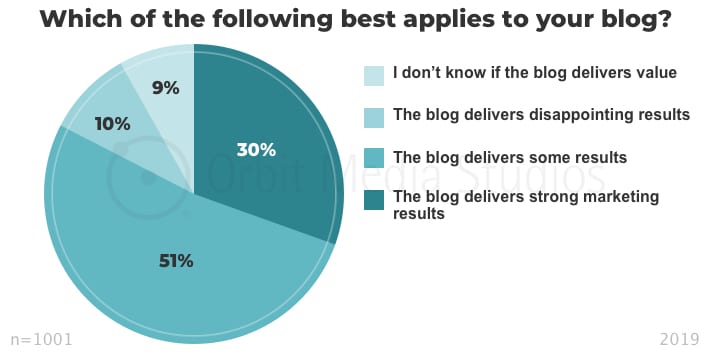
Is there a trend here? No. These numbers have changed very little over the last four years.
Bonus: What are the biggest blogging challenges?
This year we added a few questions about the challenges. What is the hardest thing about blogging. The most common answer is personal: finding time.
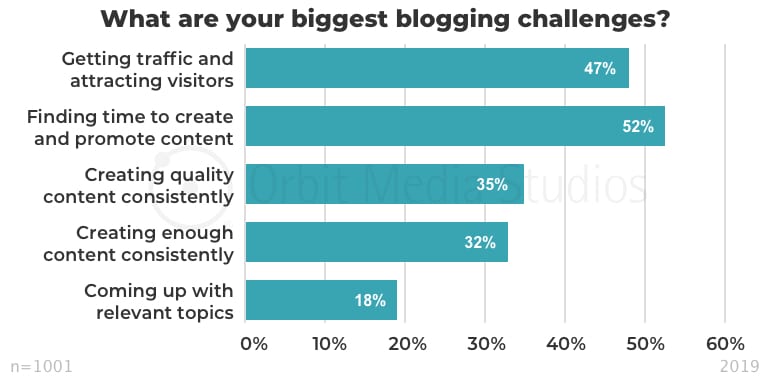
We included an “other” category and gave respondents the opportunity to add their own answers. The most common responses were related specifically to business blogging: getting internal buy-in and measurement/attribution.
The challenges are timeless, but when we ask bloggers what’s getting harder now, we see where the headwinds are coming from.

 |
henneke duistermaat, ENCHANTING MARKETING“If reader engagement feels like your biggest challenge, it’s worth asking yourself whether your content strategy needs fine-tuning. Do you have a clear idea who your ideal reader is and how you can help them solve their problems, answer their questions and achieve their aims? Is the traffic to your site relevant? Are you writing to engage your reader or to impress Google? How human is your writing?” |
 |
robert rose, founder, THE CONTENT ADVISORY“It’s no surprise, but it’s very refreshing to see the quantity and quality challenge expressed in such contrast. Time spent on each post is up. Length and exploration of depth is up. And the biggest mentioned challenge to not only attract attention but hold it. A loud noise gets your attention – but it’s what kind of noise you’re making that determines whether people stay and listen.” |
Bloggers are struggling with search and social more than email marketing. This is probably because search and social are dominated by digital monopolies, which control user experience. Google and Facebook have reduced clickthrough rates to websites in order to keep visitors on their platforms. But email isn’t owned by anyone. There’s no intermediary between the blogger and their audience. Bloggers are reporting an easier time.
Most bloggers (54%) are finding it harder to keep visitors engaged with content. It’s a constant struggle. The signals that indicate that a reader is connecting with the post aren’t looking good.
Two key takeaways
There are a few big themes here. There seem to be two main factors that are the strongest indicators of success: depth and consistency.
Deep Content
Bloggers who do more are getting better results. These are the bloggers most likely to report success:
- Bloggers who write 2000+ words
- Bloggers who include 10+ images per post
- Bloggers who consider 20+ headlines
Consistent Performance
Bloggers who are more consistent are getting better results. These are the bloggers most likely to report success:
- Bloggers who always research keywords report strong results
- Bloggers who always collaborate on content report strong results
- Bloggers who always check Analytics report strong results
These tactics are so effective because bloggers are using them every time.
Methodology and Data
The respondents to this survey are self-described bloggers that we connected with over many years on social media and at live events. The data set is heavily populated with my network, which skews toward LinkedIn users, B2B marketers and people in the US. Responses were gathered from July through September 2019.
No one was incentivized to take the survey. This is a survey of bloggers (individuals), not companies or brands (groups). Here are the three ways we gathered responses along with our estimates for their contribution:
- Email to past respondents (30% of responses)
- Social media and shares by influencers (30% of responses)
- Individual outreach through messages and email (40% of responses)
This survey is well known in our industry. It’s likely that many respondents have seen the correlation data. It’s possible that this has affected some responses. “I remember this survey. It shows that writing longer posts is good. I should say that I write long posts…”
Data was captured using a simple one-page survey of 19 questions. Early versions of the blogging statistics and trends were sent to influencers to gather insights, which correlations and pivot tables were created at Orbit. The insights and data were analyzed in the wee hours in a dark kitchen. Finally, images and editing were handled by the small but powerful content team at Orbit.
How is this survey promoted? Read our playbook here.
Thank you
First, thank you respondents, all 1001 of you. You spent 3 minutes and 10 seconds on average. Together that’s 52 hours and 50 minutes (that’s the final statistic, I promise) and shed light on a dark corner of the content world.
Thanks to the contributors. They are all my teachers. I recommend following, subscribing and reading each of them. We are grateful for your insights and for your help promoting the survey.
- Thanks to Morgan at the team at Survey Monkey. Your tools are the best.
- Thanks to Taylor and his team at Digital Third Coast for the promotion boost.
- Thanks to Spela at Databox for helping to gather responses.
- Thanks to Emilee and the team at Don’t Panic Management for the outreach help.
And finally, thanks to Amanda Gant, Janzten Loza and Joe Daleo, the Orbiteers who supported this project year after year!
The post [New Research] How has Blogging Changed? 5 Years of Blogging Statistics, Data and Trends appeared first on Orbit Media Studios.
from Orbit Media Studios https://www.orbitmedia.com/blog/blogging-statistics/
via IFTTT
from
https://sarahbarnett0.wordpress.com/2019/10/17/new-research-how-has-blogging-changed-5-years-of-blogging-statistics-data-and-trends/
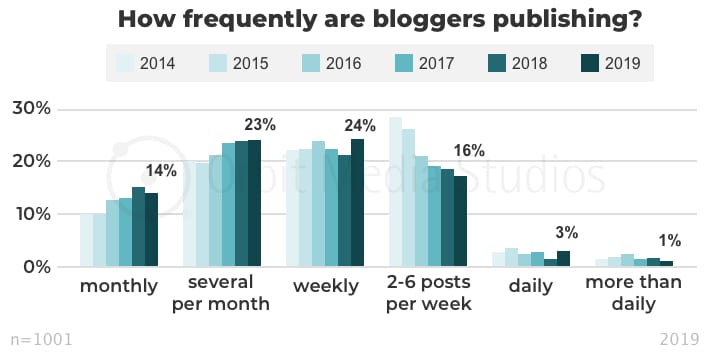
No comments:
Post a Comment